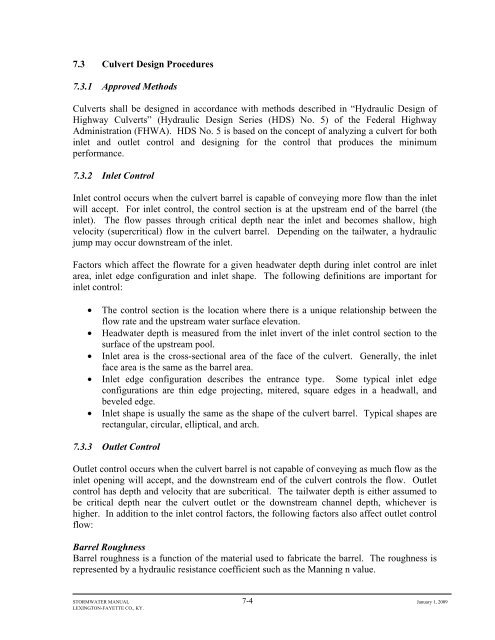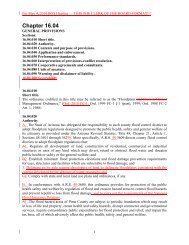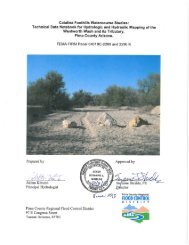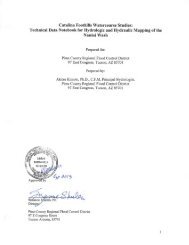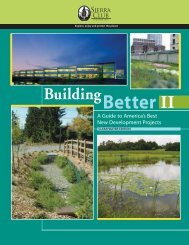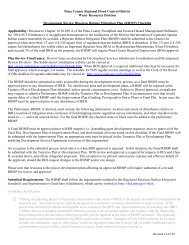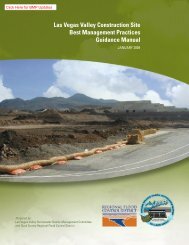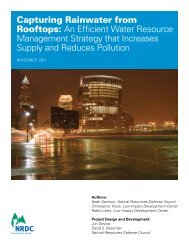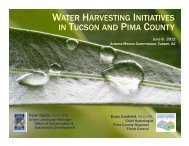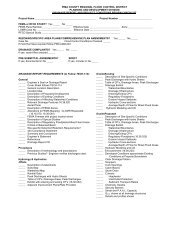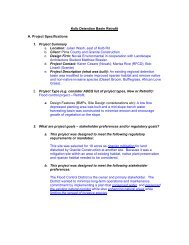Stormwater Manual - Pima County Flood Control District
Stormwater Manual - Pima County Flood Control District
Stormwater Manual - Pima County Flood Control District
You also want an ePaper? Increase the reach of your titles
YUMPU automatically turns print PDFs into web optimized ePapers that Google loves.
7.3 Culvert Design Procedures<br />
7.3.1 Approved Methods<br />
Culverts shall be designed in accordance with methods described in “Hydraulic Design of<br />
Highway Culverts” (Hydraulic Design Series (HDS) No. 5) of the Federal Highway<br />
Administration (FHWA). HDS No. 5 is based on the concept of analyzing a culvert for both<br />
inlet and outlet control and designing for the control that produces the minimum<br />
performance.<br />
7.3.2 Inlet <strong>Control</strong><br />
Inlet control occurs when the culvert barrel is capable of conveying more flow than the inlet<br />
will accept. For inlet control, the control section is at the upstream end of the barrel (the<br />
inlet). The flow passes through critical depth near the inlet and becomes shallow, high<br />
velocity (supercritical) flow in the culvert barrel. Depending on the tailwater, a hydraulic<br />
jump may occur downstream of the inlet.<br />
Factors which affect the flowrate for a given headwater depth during inlet control are inlet<br />
area, inlet edge configuration and inlet shape. The following definitions are important for<br />
inlet control:<br />
• The control section is the location where there is a unique relationship between the<br />
flow rate and the upstream water surface elevation.<br />
• Headwater depth is measured from the inlet invert of the inlet control section to the<br />
surface of the upstream pool.<br />
• Inlet area is the cross-sectional area of the face of the culvert. Generally, the inlet<br />
face area is the same as the barrel area.<br />
• Inlet edge configuration describes the entrance type. Some typical inlet edge<br />
configurations are thin edge projecting, mitered, square edges in a headwall, and<br />
beveled edge.<br />
• Inlet shape is usually the same as the shape of the culvert barrel. Typical shapes are<br />
rectangular, circular, elliptical, and arch.<br />
7.3.3 Outlet <strong>Control</strong><br />
Outlet control occurs when the culvert barrel is not capable of conveying as much flow as the<br />
inlet opening will accept, and the downstream end of the culvert controls the flow. Outlet<br />
control has depth and velocity that are subcritical. The tailwater depth is either assumed to<br />
be critical depth near the culvert outlet or the downstream channel depth, whichever is<br />
higher. In addition to the inlet control factors, the following factors also affect outlet control<br />
flow:<br />
Barrel Roughness<br />
Barrel roughness is a function of the material used to fabricate the barrel. The roughness is<br />
represented by a hydraulic resistance coefficient such as the Manning n value.<br />
STORMWATER MANUAL 7-4 January 1, 2009<br />
LEXINGTON-FAYETTE CO., KY.


